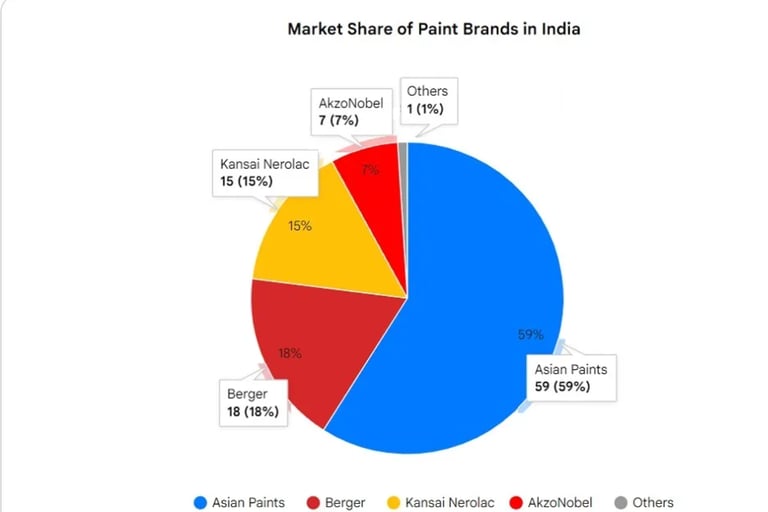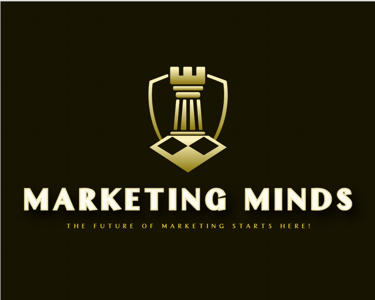Understanding the Paint Industry: Marketing Strategies and Insights for Success
INDUSTRY INSIGHTS
2/5/20255 min read

Understanding the Paint Industry: Marketing Strategies and Insights for Success


I. Overview of the Paint Industry
A. Historical Context
The paint industry has evolved significantly, from the use of natural pigments in ancient civilizations to modern synthetic formulations. Key milestones include:
The introduction of lead-free paints for safer applications.
The rise of water-based paints to reduce environmental impact.
Technological advancements in coatings for sustainability and performance.
In 2023, the global paint and coatings industry was estimated to be valued at some 179.98 billion U.S. dollars. It is forecast that by 2032 the sector’s market value will surpass 255.59 billion U.S. dollars. The India Paints And Coatings Market size is estimated at USD 10.46 billion in 2025, and is expected to reach USD 16.37 billion by 2030, at a CAGR of 9.38% during the forecast period (2025-2030) with major players like Asian Paints, Berger Paints, Nerolac, and AkzoNobel leading industry growth through innovation and strategic marketing.
B. Types of Paints
Water-Based vs. Oil-Based Paints – Water-based paints are favored for their low toxicity and ease of application, while oil-based paints provide superior durability and gloss.
Industrial vs. Decorative Paints – Industrial paints are used for infrastructure, automotive, and machinery, whereas decorative paints serve home and commercial interiors.
Specialty Paints – Includes heat-resistant coatings, anti-microbial paints, and eco-friendly formulations.
C. Market Segmentation
Residential vs. Commercial – Homeowners drive demand for decorative paints, whereas commercial projects require durable coatings with higher performance standards.
Geographic Segmentation – Demand varies based on urbanization, climate, and regional preferences.
Demographic Segmentation – Millennials prefer DIY solutions, while older consumers may rely on professional painting services.
II. Marketing Strategies of Leading Paint Companies
A. Digital Marketing Strategies
Asian Paints:
Heavy investment in digital transformation with AI-driven recommendations.
Colour Visualizer Tool allows customers to digitally preview colors on their walls.
Social media engagement through influencer collaborations and interactive content.
Berger Paints:
Strong emphasis on content marketing, including DIY painting guides.
Targeted digital ads focusing on price-sensitive and eco-conscious consumers.
E-commerce expansion with partnerships on platforms like Amazon.
Nerolac Paints:
Uses YouTube and Instagram for tutorial videos showcasing innovative paint solutions.
Augmented Reality (AR) integration for virtual room painting.
AkzoNobel:
Focus on B2B marketing through LinkedIn and industry-specific webinars.
Data-driven digital campaigns targeting professionals in the construction and design sectors.
B. Sustainability and Eco-Friendly Practices
Asian Paints:
Launched low-VOC (Volatile Organic Compound) paints to reduce environmental impact.
CSR initiatives focused on sustainable home improvement projects.
Berger Paints:
Developed anti-bacterial and odor-free paints for healthier living spaces.
Active in promoting Green Seal certified products.
Nerolac Paints:
Strong advocacy for lead-free paints and sustainable manufacturing processes.
Partnering with regulatory bodies for eco-compliant products.
AkzoNobel:
Pioneered energy-efficient coatings for industrial applications.
Global commitment to reducing carbon footprint through sustainable packaging.
C. Innovation in Product Offerings
Asian Paints:
Introduced SmartCare Damp Proof to address moisture issues.
Offers customized shades using AI-based recommendations.
Berger Paints:
Launched WeatherCoat Anti-Dust Paint to tackle pollution-related concerns.
Special emphasis on long-lasting exterior finishes.
Nerolac Paints:
Focused on stain-resistant interior paints.
Launched Eco Clean range promoting indoor air quality improvement.
AkzoNobel:
Developed self-cleaning paints for industrial surfaces.
Leveraging nanotechnology for advanced coating solutions.
III. Competitive Analysis of Marketing Strategies
A. Porter’s Five Forces Analysis for the Paint Industry in India
1. Threat of New Entrants – Moderate to High
🔹 Barriers to Entry: Moderate
🔹 Factors:
Economies of Scale (High): Large players benefit from cost advantages due to bulk production, making it difficult for new entrants.
Brand Loyalty & Product Differentiation (High): Consumers prefer trusted brands like Asian Paints, making it hard for new entrants to gain market share.
Capital Requirement (Moderate): Setting up manufacturing and R&D facilities requires moderate capital investment.
Access to Distribution Channels (Difficult): Large players dominate supply chains and have strong dealer relationships.
Government Regulations (Moderate): New entrants must comply with environmental regulations (VOC emissions) and safety standards.
Conclusion: Threat is Moderate to High due to strong existing brands and distribution dominance.
2. Bargaining Power of Suppliers – Low to Moderate
🔹 Factors:
Raw Materials (Titanium Dioxide, Resins, Pigments, Solvents): India has multiple suppliers, reducing their bargaining power.
Backward Integration (High by Large Players): Big companies have their own manufacturing plants, reducing dependence on suppliers.
Global Sourcing (Moderate): Some raw materials are imported, but alternative sources exist.
Conclusion: Low to Moderate supplier power due to availability of multiple raw material sources.
3. Bargaining Power of Buyers – High
🔹 Factors:
Multiple Options (High Competition): Consumers have choices between premium and budget brands.
Price Sensitivity (High): Bulk buyers (real estate developers, infrastructure projects) demand lower prices.
Switching Cost (Low): Customers can easily switch brands based on price, quality, or marketing.
Brand Loyalty (Moderate): Large players maintain loyalty through marketing, innovation, and dealer networks.
Conclusion: High bargaining power of buyers, especially in bulk purchases.
4. Threat of Substitutes – Low to Moderate
🔹 Factors:
Wallpapers & Decorative Laminates: Alternative interior solutions but have higher costs.
Tiles & Wood Panels: Used in specific cases, but cannot completely replace paints.
Eco-Friendly & DIY Coatings: Emerging trend, but adoption is slow in India.
Conclusion: Low to Moderate threat from substitutes since paint remains the most cost-effective choice.
5. Industry Rivalry – Very High
🔹 Factors:
Intense Competition: Dominated by big players (Asian Paints, Berger, Kansai Nerolac, Akzo Nobel), along with unorganized players.
Price Wars & Discounts: Companies offer promotions and discounts to retain market share.
Product Differentiation: Brands compete based on quality, durability, eco-friendliness, and innovation (e.g., anti-bacterial, weather-resistant paints).
Advertising & Brand Positioning: Heavy spending on marketing to maintain dominance.
Conclusion:Very High Rivalry due to a competitive market and continuous innovation.
B. Target Audience and Customer Behavior
Asian Paints – Targets both urban homeowners and contractors, leveraging technology for personalization.
Berger Paints – Appeals to budget-conscious and eco-conscious consumers.
Nerolac Paints – Strength in the B2B and industrial paint segment.
AkzoNobel – Primarily B2B-focused, catering to industrial applications and large-scale projects.
C. Pricing and Distribution Strategies
Asian Paints:
Premium pricing strategy for quality-conscious consumers.
Strong dealer network ensures deep market penetration.
Berger Paints:
Value-for-money approach with cost-effective products.
Strong presence in semi-urban and rural areas.
Nerolac Paints:
Competitive pricing targeting bulk buyers and businesses.
Expanded partnerships with construction and real estate firms.
AkzoNobel:
B2B-centric pricing model catering to large-scale industrial buyers.
Direct partnerships with architects and interior designers.
D. Customer Engagement and Retention Strategies
Asian Paints:
Loyalty programs for contractors.
AI-driven customer service chatbots for real-time assistance.
Berger Paints:
Community engagement initiatives such as free color consultations.
DIY workshops to educate customers on home painting.
Nerolac Paints:
Offers long-term warranties on premium products.
Incentive programs for dealers to drive sales.
AkzoNobel:
Corporate training programs for professional painters.
Customization options for high-end industrial clients.
IV. Challenges and Opportunities in the Paint Industry
A. Supply Chain and Distribution Challenges
Global raw material shortages impact cost fluctuations.
Companies are adopting smart logistics solutions to optimize distribution.
B. Adaptation to Market Changes
Post-pandemic digital transformation has accelerated e-commerce adoption.
AR and AI integrations provide enhanced customer experiences.
C. Predictions for Future Market Developments
Growth in anti-microbial and smart coatings.
Increased consumer demand for eco-friendly products.
Expanding into tier 2 and tier 3 cities for market penetration.
Conclusion
The paint industry is witnessing rapid transformation driven by digital innovation, sustainability, and shifting consumer preferences. Asian Paints leads the market with cutting-edge technology and strong branding, Berger Paints focuses on value-driven and eco-friendly options, Nerolac excels in industrial coatings, and AkzoNobel dominates the B2B space. Each player is adopting unique strategies to cater to diverse market needs, ensuring competitiveness in a dynamic industry.


Connect
Stay updated with our latest marketing insights.
Follow
Subscribe
+919818636980
© 2025. All rights reserved.
